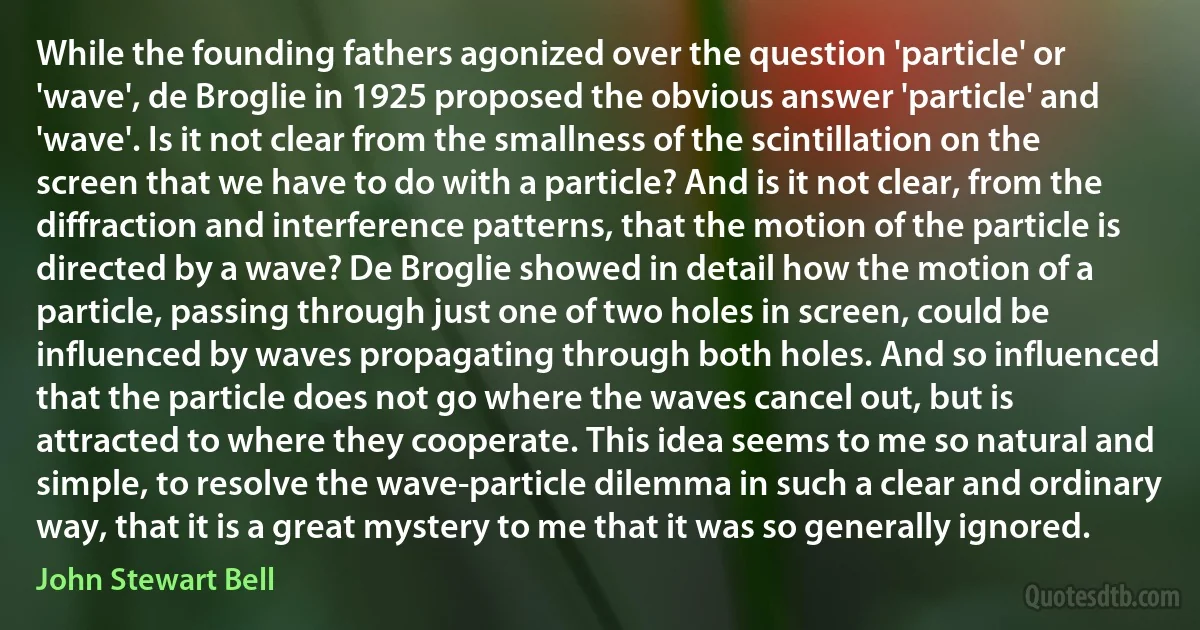
While the founding fathers agonized over the question 'particle' or 'wave', de Broglie in 1925 proposed the obvious answer 'particle' and 'wave'. Is it not clear from the smallness of the scintillation on the screen that we have to do with a particle? And is it not clear, from the diffraction and interference patterns, that the motion of the particle is directed by a wave? De Broglie showed in detail how the motion of a particle, passing through just one of two holes in screen, could be influenced by waves propagating through both holes. And so influenced that the particle does not go where the waves cancel out, but is attracted to where they cooperate. This idea seems to me so natural and simple, to resolve the wave-particle dilemma in such a clear and ordinary way, that it is a great mystery to me that it was so generally ignored.
John Stewart BellRelated topics
answer clear diffraction founding great idea interference natural passing question simple smallness way whileRelated quotes
This morning I received a letter from de Bellio. He writes that he does not believe scientific research into the nature of color and light can help the artist, neither can anatomy nor the laws of optics. He wants to discuss these questions with me and find out my views. Now everything depends on how this knowledge is to be used. But surely it is clear that we could not pursue our studies of light with much assurance if we did not have as a guide the discoveries of Chevreul and other scientists. I would not have distinguished between local color and light if science had not given us the hint; the same holds true for complementary colors, contrasting colors, etc. 'Yes', he will tell me: 'but these have always been taken into account, look at Monet' It is at this point that the question becomes serious!

Camille Pissarro
In retrospect, the reason for the assassination is hardly a mystery. It is now abundantly clear ... why the C. I. A.'s covert operations element wanted John Kennedy out of the Oval Office and Lyndon Johnson in it. The new President elevated by rifle fire to control of our foreign policy had been one of the most enthusiastic American cold warriors.... Johnson had originally risen to power on the crest of the fulminating anti-communist crusade which marked American politics after World War II. Shortly after the end of that war, he declaimed that atomic power had become 'ours to use, either to Christianize the world or pulverize it' -- a Christian benediction if ever there was one. Johnson's demonstrated enthusiasm for American military intervention abroad ... earned him the sobriquet 'the senator from the Pentagon....

Jim Garrison
I'm against these aggressive tax avoidance schemes but I'm not just against them, this Government has taken a huge amount of steps to legislate and toughen the laws and go after aggressive tax avoidance schemes for the very simple reason that if people go after these schemes and aggressively avoid tax they're making it the case that everyone else has to pay higher taxes as a result so I think we should be very clear, tax evasion is illegal and for that you can be prosecuted, you can go to prison for tax evasion. Tax avoidance is in these cases, very aggressive tax avoidance schemes, they are wrong and we should really persuade not to do them and that's why we have these court cases where the court looks at whether a scheme is really about avoiding tax rather than anything else and the court was very clear in this case.

David Cameron
Don't forget that God sees you and watches you when you are in pain; He perceives even the beating of your heart. Consequently, He will not leave you without consolation and His fatherly protection. Naturally, the saints rejoiced in their afflictions; as for us, let us at least manage to accept affliction or pain patiently.
My child, pray within your heart, and the name of Jesus will become for you a comforting balm so that you can bear this trial of yours in a way which benefits you. You will greatly benefit from this trial if you submit yourself to it patiently. So again I say to you, with the almighty armor of prayer continually approach the omnipotent Lord more often, and you will come to know how He wondrously lifts the burden of pain and marvellously gives rest to sufferers.

Ephraim of Arizona
So if you happen to bump into a Democrat candidate, you might want to ask this simple question: What's your plan? If they say they want to protect the homeland, but oppose the Patriot Act, ask them this question: What's your plan? If they say they want to uncover terrorist plots, but oppose listening in on terrorist conversations, ask them this question: What's your plan? If they say they want to stop new attacks on our country, but oppose letting the CIA detain and question the terrorists who might know what those plots are, ask them this question: What's your plan? If they say they want to win the war on terror, but call for America to pull out from what al Qaeda says is the central front in this war, ask them this question: What's your plan?...The truth is, the Democrats can't answer that question. Harsh criticism is not a plan for victory. Second-guessing is not a strategy.

George W. Bush
